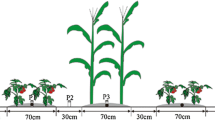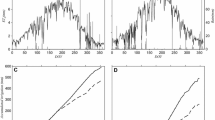Abstract
Distribution of water and energy is non-uniform in widely spaced, micro-irrigated, hedgerow crops. For accurate water use predictions, this two-dimensional variation in the energy and water balance must be adequately accounted for. To this end, a user-friendly, two-dimensional, mechanistic soil water balance model (SWB-2D), has been developed. Energy is partitioned at the surface depending on solar orientation, row direction and canopy size, shape and leaf area density. Water is assumed to be distributed uniformly at the surface in the case of rainfall, whilst micro-irrigation only wets a limited portion of the field. Crop water uptake is calculated as a function of evaporative demand, soil water potential and root density. Evaporation is also calculated as being either limited by available energy or by water supply. Water is redistributed in the soil in two dimensions with a finite difference solution to the Richards’ equation. A field trial was set up to test the 2-D soil water balance model in a citrus orchard at Syferkuil (Pietersburg, South Africa). Model predictions generally compared well to actual soil water content measured with time domain reflectometry probes. Scenario modelling and analyses were carried out by varying some input parameters (row orientation, canopy width, wetted diameter and fraction of roots in the wetted volume of soil) and observing variations in the output of the soil water balance. The model holds potential for improving irrigation scheduling and efficiency through increased understanding and accuracy in estimating soil water reserves, since it accounts for the differing conditions in the under-tree irrigated strip and inter-row rainfed areas.







Similar content being viewed by others
References
Allen RG, Pereira LS, Raes D, Smith M (1998) Crop evapotranspiration: guidelines for computing crop water requirements. (Irrigation and drainage paper no. 56) FAO, Rome
Annandale JG, Benadé N, Jovanovic NZ, Steyn JM, Du Sautoy N (1999) Facilitating irrigation scheduling by means of the soil water balance model. (Water research commission report no. 753/1/99) Pretoria, South Africa
Annandale JG, Campbell GS, Olivier FC, Jovanovic NZ (2000) Predicting crop water uptake under full and deficit irrigation: an example using pea (Pisum sativum L. cv. Puget). Irrig Sci 19:65–72
Annandale JG, Jovanovic NZ, Mpandeli NS, Lobit P, Du Sautoy N, Benadé N (2001) Two-dimensional energy interception and water balance model for hedgerow tree crops. (Water research commission report no. K5/945) Pretoria, South Africa
Bennie ATP, Coetzee MJ, Antwerpen R van, Rensburg LD van, Burger R du T (1988) ‘n Waterbalansmodel vir besproeiing gebaseer op profielwatervoorsieningstempo en gewaswaterbehoeftes (in Afrikaans). (Water research commission report no. 144/1/88) Pretoria, South Africa
CAMASE (1995) Newsletter of Agro-ecosystems modelling, extra edition. AB-DLO, Wageningen, The Netherlands
Campbell GS (1977) An Introduction to environmental biophysics. Springer, Berlin Heidelberg New York
Campbell GS (1985) Soil physics with Basic. Elsevier Science, Amsterdam
Campbell GS, Diaz R (1988) Simplified soil–water balance models to predict crop transpiration. In: Bidinger FR, Johansen C (eds) Drought research priorities for the dryland tropics. ICRISAT, India, pp 15–26
Campbell GS, Stockle CO (1993) Prediction and simulation of water use in agricultural systems. In: International crop science, vol I. Crop Science Society of America, Madison, Wis., USA, pp 67–73
Charles-Edwards DA, Thornley HM (1973) Light interception by an isolated plant: a simple model. Ann Bot 37:919–928
Charles-Edwards DA, Thorpe MR (1976) Interception of diffuse and direct-beam radiation by a hedgerow apple orchard. Ann Bot 40:603–613
Crosby CT (1996) SAPWAT 1.0: a computer program for estimating irrigation requirements in Southern Africa. (Water research commission report no. 379/1/96) Pretoria, South Africa
FAO (1998) World reference base for soil resources. (World soil resources report no. 84) FAO, Rome
Hodges T, Ritchie JT (1991) The CERES–wheat phenology model. In: Hodges T (ed) Predicting crop phenology. CRC, Boca Raton, Fla.
International Ground Water Modeling Center (1996) Hydrus-2D CD-ROM. Colorado School of Mines, Golden, Colo., USA
Knight JH (1992) Sensitivity of time domain reflectometry measurements to lateral variations in soil water content. Water Resour Res 28(9):2345–2352
Redinger GJ, Campbell GS, Saxton KE, Papendick RI (1984) Infiltration rate of slot mulches: measurement and numerical simulation. Soil Sci Soc Am J 48:982–986
Ross PJ, Bristow KL (1990) Simulating water movement in layered and gradational soils using the Kirchhoff transform. Soil Sci Soc Am J 54:1519–1524
Singels A, De Jager JM (1991a) Refinement and validation of PUTU wheat crop growth model. 1. Phenology. S Afr J Plant Soil 8(2):59–66
Singels A, De Jager JM (1991b) Refinement and validation of PUTU wheat crop growth model. 2. Leaf area expansion. S Afr J Plant Soil 8(2):67–72
Singels A, De Jager JM (1991c) Refinement and validation of PUTU wheat crop growth model. 3. Grain growth. S Afr J Plant Soil 8(2):73–77
Smith M (1992) CROPWAT: a computer program for irrigation planning and management. (FAO irrigation and drainage paper no. 46) FAO, Rome
Tanner CB, Sinclair TR (1983) Efficient water use in crop production: research or re-search? In: Taylor HM, Jordan WR, Sinclair TR (eds) Limitations to efficient water use in crop production. ASA, CSSA and SSSA, Madison, Wis., USA
Acknowledgement
The authors acknowledge funding from the Water Research Commission (Pretoria, South Africa).
Author information
Authors and Affiliations
Corresponding author
Additional information
Communicated by K. Bristow
Appendix
Appendix
Finite difference flux equations and derivatives
In the finite difference flux equations, positive values represent fluxes into the control volume:
Note that vertical fluxes include gravitational components.
The derivatives of the flux equations and storage term are:
Rights and permissions
About this article
Cite this article
Annandale, J.G., Jovanovic, N.Z., Campbell, G.S. et al. A two-dimensional water balance model for micro-irrigated hedgerow tree crops. Irrig Sci 22, 157–170 (2003). https://doi.org/10.1007/s00271-003-0081-7
Received:
Accepted:
Published:
Issue Date:
DOI: https://doi.org/10.1007/s00271-003-0081-7




